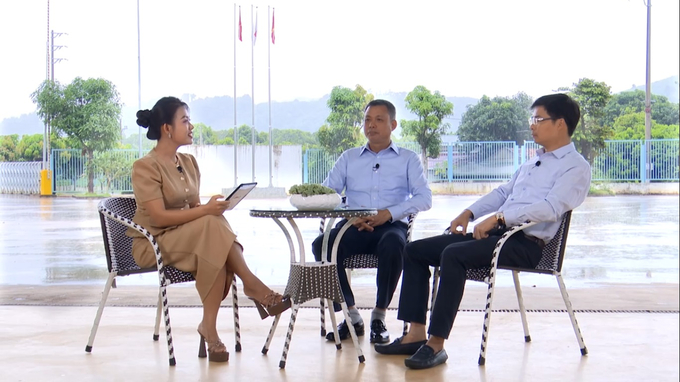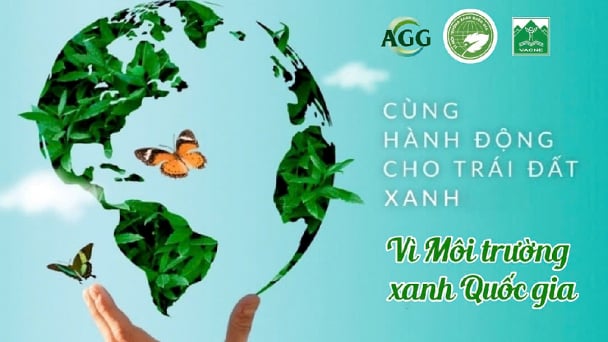May 19, 2025 | 16:30 GMT +7
May 19, 2025 | 16:30 GMT +7
Hotline: 0913.378.918
May 19, 2025 | 16:30 GMT +7
Hotline: 0913.378.918
Editor's note: Son La's agriculture is shifting strongly with the green and fast desire and towards clean production and applying high technology. Son La is building large raw material areas to serve production and processing; attracting investment from large businesses such as DOVECO to complete the production chain; and continuously searching and developing markets.
After a transformation process, Son La has had lessons in building linkage chains and solutions to develop the agricultural product market. To clarify these issues, Vietnam Agriculture Newspaper organized a talk show with two esteemed guests: Mr. Nguyen Thanh Cong, Vice Chairman of the Son La Provincial People's Committee, and Mr. Nguyen Thanh Tung, Deputy General Director of Dong Giao Foodstuff Export Joint Stock Company (DOVECO).
Mr. Nguyen Thanh Cong, Looking back at the transformation of Son La province from a poor corn capital in the past to a key fruit-growing region in the Northern mountainous area, many people call Son La's agriculture a phenomenon. So in your opinion, what caused that phenomenon, sir?
Mr. Nguyen Thanh Cong: During the past years, Son La has focused on leadership and direction to develop agriculture, turning Son La into a strong province in agricultural development nationwide. Along with that is the support from Ministries and Central branches, especially the Ministry of Agriculture and Rural Development, and economic corporations so that Son La could focus on agricultural development.

Son La's area of fruit trees by the end of 2023 is 84,160 hectares. Photo: Tung Dinh.
To become a province with strong agricultural development, Son La has implemented many solutions, of which there are three important contents. The first is the determination, leadership, and direction of Party Committees at all levels, from the Provincial Party Committee, the Provincial People's Council, and the Provincial People's Committee to all departments, branches, and unions; the entire system of cadres, civil servants, and public employees; and people throughout the province.
The average GRDP growth of the entire agro-forestry-fisheries sector in the 2020–2023 period in Son La reaches 5.1%/year. The total annual cultivated area is 212,602 hectares, of which the area of fruit trees by the end of 2023 is 84,160 hectares.
The second is to focus on shifting crop structure with great determination and effort to convert short-day, ineffective food crops to fruit trees with high productivity, quality, and economic efficiency. The third is to focus on the production field, from production scale to production organization that must ensure clean production processes and meet domestic and international standards, and focus on processing agricultural products.
Additionally, focus on attracting investment to have a system of large processing factories associated with a production process and a stable production chain between businesses, cooperatives, farmers, and all households who are currently engaged in agricultural production.
The whole process of developing Son La's agriculture is drawn from experience in production, consumption, and processing of agricultural products and the efforts of the government at all levels and people throughout the province.
Mr. Nguyen Thanh Cong, Could you share some goals and development orientations for fruit trees in particular and agricultural products in general in Son La in the coming time, sir?
Mr. Nguyen Thanh Cong: Son La has shaped for the entire 2015-2020 and 2020-2025 periods and prepared socio-economic goals for the 2025-2030 period. Specifically, the first goal is to continue developing the agricultural economy in a sustainable way with the following specific targets:
Firstly, the average GDP growth of agriculture will remain at 5.5%. Secondly, agriculture will account for about 21% of the economic structure. Thirdly, continue the goal of stabilizing the fruit tree area, over 84,000 hectares existing and 100,000 hectares by the end of 2025. Then focus on deep processing to produce products with high quality, productivity, and economic efficiency.

Vietnam Agriculture Newspaper's talk show with Mr. Nguyen Thanh Cong (middle) and Mr. Nguyen Thanh Tùng (right). Photo: VAN.
The second important goal is to build a stable production chain between producers, cooperatives, and businesses. To do that, it is compulsory to build a strong and quality cooperative system throughout the province and ensure the implementation of linkages.
The third goal is to continue promoting the consumption and export of agricultural products. Of which, pay attention to foreign markets. Currently, Son La's agricultural products have been exported to 21 countries and territories around the world. And pay attention to the domestic market to build product brands and quality, and aim at high-quality consumers.
The fourth goal is very clear, which is to focus on and continue attracting large processing factories of economic corporations. These corporations will contribute to the stronger development of Son La province's production chain as well as contribute to increasing the value of agricultural production and other crops.

Arabica coffee in Son La. Photo: Tung Dinh.
Another goal is to maintain, stabilize, and develop industrial crops. In addition to fruit trees, Son La has coffee, tea, and cassava. Especially with more than 22,000 hectares of Arabica coffee along with coffee factory chains, Son La will continue to stabilize and develop tea and coffee industrial processing factories. Son La will also continue to develop the fisheries industry in the coming time.
From DOVECO Son La's practice, what recommendations and suggestions do you have to make the production chain in Son La increasingly stronger, Mr. Nguyen Thanh Tung?
Mr. Nguyen Thanh Tung: In recent years, DOVECO has received the comprehensive attention of the Provincial Party Committee, People's Council, and People's Committee of Son La province to invest in building a processing factory. Besides, Son La's system of over 700 cooperatives throughout the province is also a huge advantage for DOVECO to link with farmers through cooperatives and cooperative groups to develop raw material areas.
Therefore, DOVECO has only had one suggestion. It is recommended that the Son La Provincial People's Committee continue to pay attention and support farmers on two following things: First is the road system to transport raw materials from planting sites to processing factories. Second is an irrigation system so that farmers can take better care of their crops, because the biggest difficulty in Son La in the dry season is the problem of irrigation water.
In the 2021-2023 period, Son La province issued new investment policies for six projects, including: Doveco fruit and vegetable processing center; Glucose BHL Son La liquid sugar processing factory; Agricultural product processing factory of Nafoods Tay Bac Joint Stock Company; Moc Chau agricultural product processing and preservation investment project of Tay Bac Trading Company; Moc Chau ecological farm and high-tech dairy cow farm complex of Moc Chau Dairy Cattle Breeding Joint Stock Company; and coffee processing factory of Son La Coffee Processing Joint Stock Company.
Thank you, sir!
Translated by Thu Huyen

(VAN) 14 out of 35 domesticated elephants in Dak Lak province have had their living conditions improved, with 11 of them currently participating in the non-riding elephant tourism model.

(VAN) Muong Nhe Nature Reserve hopes that being upgraded to a national park will lay the foundation for forest protection efforts to be carried out in a systematic, modern, and sustainable manner.
/2025/05/16/3923-2-171845_52.jpg)
(VAN) Lower costs, higher yields, and improved soil quality are outstanding benefits that soybeans bring when integrated into the crop rotation system.

(VAN) The 'For a Green National Environment' programme aims to promote a green lifestyle, support businesses in implementing ESG practices, and turn Net Zero commitments into concrete actions.

(VAN) Cold-barn systems efficiently manage environmental and temperature conditions, which aids in the prevention of respiratory diseases in pigs and protects them from the vectors that transmit African swine fevers.

(VAN) To tackle challenges, the project 'Addressing key technical bottlenecks in the grouper supply chain in Vietnam' has been underway since 2024.

(VAN) The project 'Disease-Resilient and Sustainable Cassava Production Systems in the Mekong Region', funded by the Australian Center for International Agricultural Research (ACIAR), is being implemented from 2024 to 2028.